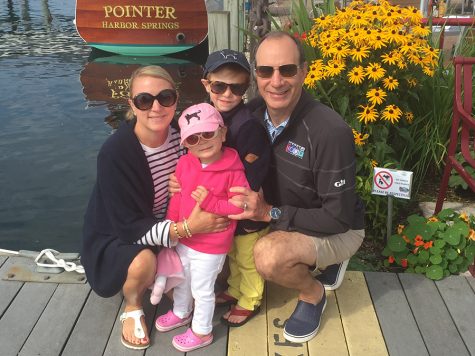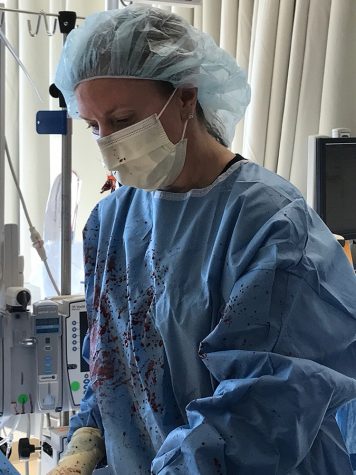A Unicorn Surgeon
Dr. Jennifer Romano reflects on the differences between men and women in pediatric cardiothoracic surgery.
The phrase “as rare as a unicorn” can be used to describe Jennifer Romano’s career: she is a self-proclaimed “part time” pediatric heart surgeon. She is also the mother of two children: Maximillian, four, and Allegra, two. She has to choose between these jobs sometimes. During our interview, the usually fashionable Dr. Romano was wearing a mustard-stained shirt, proving that being a busy surgeon and a busy mother sometimes gets…well…busy. She is too busy for laundry sometimes, and in those times a mustard-stained shirt has to do.
Besides getting stains on her clothing at home, she often gets stains on her clothing at work. Recently, for example, Romano was home on a Sunday morning playing with her kids when she was paged to the intensive care unit (ICU) to help a patient who was bleeding into his chest. She rushed to the hospital, and without hesitation opened his chest and found that his aorta was torn open; while blood squirted up at her, getting all over her surgical gown, she sutured his aorta and saved his life. Just like at home, she got a bit messy doing what she loves.

Romano, M.D., Pediatric Cardiothoracic Surgeon at C.S. Mott Children’s Hospital (Mott), didn’t plan to be a surgeon at first. She originally wanted to go to vet school, but when asking a professor for a recommendation letter, she was told that unless she applied to medical school as well as vet school, she wouldn’t get her letter from him. So, she took the MCAT and applied to various med schools. She ended up getting into Harvard Medical School and spent the next four years of her life there.
After med school, Romano looked for residency programs that were inclusive of women. The University of Michigan was one of them. “When I came to Michigan, they had already had a strong tradition of training women,” Romano said. “When I was interviewing, there were many surgery programs that had never trained a woman and were actually very proud of that.”
One of these places was Columbia University.
When Romano walked into the room, she found she was the only woman interviewing that year. There were 19 men in dark black suits, in contrast to her grey and lavender pantsuit. “One of the attendings nudged another one and said, ‘Hey look, there’s a chick this year,’” Romano said. She was shocked that her being there was new for them.
During one of the interviews, she was asked questions that she had not anticipated: “So what are you gonna do if you start crying in the operating room? Do you think women can really be heart surgeons? Do you think that’s the right place for women?”
Her first thought during that interview was that she was being challenged. “Then I realized that no, he really thinks that,” she recalled. “I…I was just speechless. I opted not to train in a place like that. I self-selected to be in a program where that kind of mentality was not there. Certainly when I chose to go into surgery, I never wanted to be the person who broke the glass ceiling, but somehow or another by choosing to be a pediatric heart surgeon, I found myself pinned up against the glass ceiling.”
During her intern year at Michigan there were six chief residents, two of them women. The female chiefs were known as the top residents by both attendings and trainees. “It wasn’t like I had to pave the way,” Romano said. “They were already used to having women that were amazing.” Because of these strong women, Romano had great mentorship and support throughout her residency.
Romano is a pediatric cardiothoracic surgeon, meaning she operates on the hearts of children. She describes herself as working “part time” because on average she only does six surgeries a week despite doing many other tasks: she sees patients in clinic; participates in conference calls; attends team meetings; works on research projects; is a member of multiple committees; and travels to various places around the world.
“The nice thing is that my job has a lot of different facets,” Romano said. “I’d have a hard time if I had to be sitting at a desk or focused on one extended task for a long period of time. I have a lot of variability, active things.” Common stereotypes have portrayed women as wanting to do jobs with only necessary basic skills. This is a stereotype that Romano has clearly proven wrong.
Another common stereotype is that women can’t handle hard tasks or jobs. “The type of surgery I do is fairly intense,” Romano said. “Three-to-four-hours-long surgeries are common. That’s where I probably get the most satisfaction: When you have a good repair, the patient is fixed; you can tell the family, ‘You’re done, they’re fine, you can just grow them, love them, and send me holiday photos.’”
It’s often presumed that a woman in the medical field has to work harder to prove they are just as good as men. Romano doesn’t agree. “Being a woman, if anything, worked to my advantage,” she said. As a woman, she’s felt supported, whether because of her personality, luck, or just how she feels a senior male generally sees a junior female. “As weird as it is to say, I think it was easier for a senior male to look at a junior female trainee in more of a paternalistic, protective, nurturing way,” Romano said. By contrast, she has noticed that the relationship between senior male surgeons and junior male surgeons is more like a pushy father and his son.
She points out that being a woman set her apart off the bat from all the men. “I think that it worked to my advantage because it was very easy to stand out,” Romano said. “If there’s 60 guys and one woman, it was very easy for people to remember who I was, for better or for worse, probably. People got to know my name faster and better on the national scene because I wasn’t ‘just another guy.’” They also remembered her because of her skill in the operating room. One surgeon who trained with Dr. Romano said that she is considered by many to be the best technical surgeon to come from the University of Michigan training program in the last 20+ years.
Romano feels that another advantage to being a woman in her field is that it seems a lot of families gravitate towards a female surgeon. It may be easier for a mother of a kid with a broken heart to trust another mother with their child.
She’s also very cognizant of scars, and it’s often said by former patients that she focuses on operating to minimize major scarring. “They seek me out for that because I get the fact that [for example] a prom dress is important,” Romano said. “There are a few dresses in your life that are important, and if I can make it so you can wear a strapless dress, so be it.”
A big difference between being a man versus being a woman in the workforce is salary. Romano was hired for approximately 10 percent less than her male equivalents, and she continues to get paid less.

“The problem is, if you start off lower, even if you’re getting the same percentage raises, you never catch up,” she said. She can easily compare herself to a male residency classmate: one who received a higher salary and academic rank.
“We did all the same training, and I had an additional year of training, two additional board certifications, just as many publications, and he still got paid more than me,” Romano said. “He came in as an assistant professor and I came in as a lecturer.” Romano is now an assistant professor as well, but she had to work her way up to that position.
She doesn’t think that this example of treating a woman differently is a conscious decision for everyone. “I think it’s just unfortunately pervasive,” Romano said. “I don’t think people think, ‘Oh, she’s a woman, I’m gonna pay her less.’ It’s more like, ‘Oh, she’s a woman, let’s give her this salary.’ And it’s so subconscious.”
She notes that women are usually slower to get promoted, slower to move up the track, and slower to get nominated for things. She does point out that she’s been fortunate enough to have good mentorship and support, but as a whole she believes this is a clear disadvantage to being a woman. When looking at her female counterparts, many haven’t been as fortunate to have similar mentorship to hers, and their careers are at very different places than hers despite being the same number of years out from training.
There are approximately 200 pediatric cardiothoracic surgeons in the United States; of those 200, only eight are women, and only two are members of the American Association of Thoracic Surgery (AATS); Romano is the only one that is on the American Board for Thoracic Surgery. There are more adult cardiothoracic surgeons than pediatric — and more women — but if you look at the ratio of women to men for adult cardiothoracic surgeons, it’s even smaller than for pediatric cardiothoracic surgeons. So although not quite “as rare as a unicorn,” it is pretty rare.
Another clear difference between female and male surgeons is often their family. “Even though I have partners that are like, ‘Oh, we’re very involved with our kids, we totally get it,’ no, you don’t get it,” Romano said. “You don’t get the feeling of being a mom, that by six o’clock at night, I need to be the one at home, I need to get home, I need to see my kids.”
She uses her husband, an adult cardiothoracic surgeon, as a great example of this. There’s no question he loves his children, but at the end of the day he wants to get everything finished up at the hospital before going home. For Romano, on days when she’s not operating, she makes sure she leaves at six so she can go home and be with her children, moving work to second place.
Her husband is very supportive of what she does and the choices she makes. This is important to Romano given the high value she places on family and relationships in addition to work life. “I think usually men inherently are not necessarily attracted to women that have a similarly competitive or even more competitive profession than them, so that’s difficult,” Romano said.
She married her husband when she was 40 and had her children when she was 42 and 44; she and her husband were already attending surgeons. While she loves her family and the course her life has taken, these were not her ideal ages to start a family, but everyone has to make compromises and sacrifices at some point.
One piece of advice she gives female residents is about “having it all.” “You can have it all in terms of what is ‘all’ for you,” Romano said. “But I think the external world’s view of having it all — the big career, the big family — that’s somebody else putting that on you.” At this point in her career, it’s more important to her to take her kids to their swim lessons than to get those extra papers published. That’s her balance. To others, this balance may be different. Romano believes that “having it all” in terms of each person’s individual balance is one of the biggest challenges for women in the medical field.
This balance is often different for different people, just as it can become different throughout one woman’s career. In the beginning of a surgical career, there’s a lot of schooling and training, so starting a family is not the main focus for many women; later in their life, though, they may want a family. “In all honesty and sincerity, I do tell women, if you’re thinking about pursuing a career in surgery, freeze your eggs,” Romano said.
In 2014, the average age of first-time mothers was 26.3 years. When starting your residency, Romano stresses that you don’t know where life is going to take you; you aren’t going to be 26 again. “At this point in time, if you’ve invested $250,000 plus in your education, what’s investing $20,000 in your family, or future family?” Romano said.
She tells people to “really follow your heart and what you want to do.” Anyone, but especially doctors, need to really think about what they truly value in life. This could be where they want to live, what they want to do, or whether or not they want to have a family. “These things are important,” Romano said. “Embrace those values because your personal values for what you view for your life are just as important as your professional values. And I think that can very easily get lost during training.”
Finally, though difficult to talk about, there are some things that unfortunately come with being a woman in a “man’s world” that are criminal: sexual misconduct and objectification. Sadly, this has happened to Romano. When she was in college, she was part of a sexual misconduct suit. She actually didn’t speak up at first because “that’s a very awkward position to be in,” Romano said. “Especially when you’re not sure what the ramifications of speaking out are going to be.” Luckily for her, it wasn’t overly physical, mostly just sexualized, derogatory comments. However, such situations can be very damaging for women following a path like Dr. Romano.
Though the world of medicine can be difficult for many women, Michigan has set a great example for their inclusion not just as participants, but as leaders, especially the male-dominated departments. “When you look at the University of Michigan, there’s a lot of women: there’s a woman who’s the first ever female chairman of neurosurgery, and [another who’s the] first ever female chairman of head/neck surgery,” Romano said. “They’re out there.”
We are lucky to have a uniquely talented female like Dr. Romano performing pediatric cardiothoracic surgery right here in Ann Arbor. The female surgeons and leaders of the future couldn’t find a better role model.

Her life outside of the journalism lab consists of one thing: gymnastics. It takes up all of Abbie’s “free time,” but she wouldn’t be who she is today without having spent almost 13 years in the sport. Abbie also loves listening to music — believing that there is at least one song for whatever mood someone is in — and spends much of her money on going to concerts, her happy place. She simultaneously wants May (aka graduation) to come quickly, but also take its time; clearly, she’s terrible at making decisions, so it’s a good thing she has three other editors to help her through this crazy process!








